Forts of Gujarat
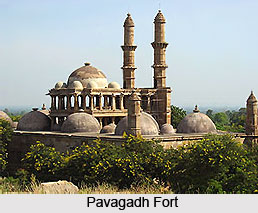 Forts of Gujarat are the relics of past that represent and narrate the ancient history of the state. These are important historical monuments which exhibit European, Islamic and Hindu architecture and sometimes a combination of different styles. The large and impressive structures of the forts adorned with beautiful artistry are the testaments of excellent craftsmanship prevalent in historical era. Many of the forts were built with the purpose of protecting the kingdom from invaders whereas many others served as royal residences. Inscriptions can also be found on the remains of these forts, including walls and pillars, which unfold many clandestine tales of history.
Forts of Gujarat are the relics of past that represent and narrate the ancient history of the state. These are important historical monuments which exhibit European, Islamic and Hindu architecture and sometimes a combination of different styles. The large and impressive structures of the forts adorned with beautiful artistry are the testaments of excellent craftsmanship prevalent in historical era. Many of the forts were built with the purpose of protecting the kingdom from invaders whereas many others served as royal residences. Inscriptions can also be found on the remains of these forts, including walls and pillars, which unfold many clandestine tales of history.
Lakhota Fort
Lakhota fort is situated in Jamnagar, Gujarat. In ancient times it was the residence of Maharaja of Nawanagar. Currently it houses a museum with artefacts belonging to the era of 9th to 18th century A.D. The articles of museum include magnificent sculpture, pottery of medieval villages around the state and many others. The fort also houses musket loops, powder flasks, guard rooms with swords and semi circular bastions. The Koath Bastion is located near the fort. It is the arsenal which was built by the royal family of Jamnagar.
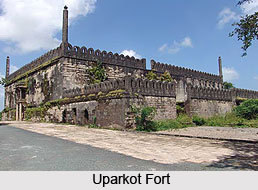 Pavagadh Fort
Pavagadh Fort
Pavagadh fort, situated in Panchmahal district, is another admirable historical monument which is known for is brilliant architecture. The fort stands on a high hill and is surrounded by hilly terrain. The place is visited by Hindus and Jains as a sacred site. A city was built around the fort by Sulatan Muhammad Beghada which came to be known as Champaner.
Uparkot Fort
Uparkot fort stands in Junagadh and is a historical monument belonging to medieval era. The fort was built during the rule of Hindu Chudasama and Nawabs of Muslim, Mohammad Beghda. The fort exhibits beautiful architecture and showcases the ruins of ancient heritage. The fort has witnessed several phases including Islamic invasions, British colonization, Jainism, Buddhism, Hinduism and Nawabs. Remains of Buddhist caves and a Jama Masjid which dates back to 2nd century A.D can also be found in the campus. The entrance gateway of the fort is beautifully adorned.
Dabhoi Fort
It is located in Darbhavati town of Gujarat. The fort was established in early 6th century AD by Siddhraj Jaisinh, the king of Gujarat. Notable architecture embellishes the fort.
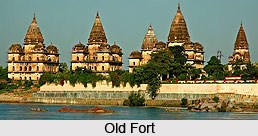
Old Fort
Old fort is another significant historical monument situated in Surat. The fort was built in 1373 A.D. during the rebellion of Gujarat, by Emperor Firoz Shah Tughlaq for protecting the town from the people of Bhill tribe. The fort was however invaded by Chhatrpati Shivaji Maharaj.
Bhujia Hill Fort
Bhujia hill fort stands before the majestic backdrop of Bhujio Hill. In fact the city of Bhuj also derived its name from the fort. It was built by Roa Godji in 1723 for protecting the city from invaders. In 1819, the fort was captured by British Colonel William Coir.
Ilva Durga
Ilva Durga is another ancient fort of Gujarat which has been also mentioned in the travelogue of the Rathore Rajputs as well as Mahabharata. Situated at the southern edge Aravalli range, the fort forms a perfect example of a naturally protected hill fort. Delicate stone carvings can be found in the ruins of the fort.
Dhoraji Fort
Dhoraji fort was constructed in 1755 AD in Porbandar. It has four main gates namely Junagadh Gate in the South, Halar Gate in the North, Porbandar Gate in the West and Kathiawadi Darwaja in the East. Darbargadh, which is a three storey structure, stands in the middle of a courtyard and is reached through a magnificently carved gateway. The architectural brilliance of the fort is worth witnessing.
Zinzuwada Fort
Zinzuwada fort belongs to 11th century AD and was built by the Solanki rulers. It stands on huge stone slabs in Rann of Kutch. It is exemplary of the perfect Hindu fort and do not bear any Islamic influences. It has four gates namely Dhama Gate, Harijan Gate, Rakshaspol Gate and Madapol Gate which are adorned with fine artistry.
Apart from being important historical monuments, forts of Gujarat also form popular tourist sites by illuminating aspects of Indian history. These forts also enrich the national heritage of the country.
Forts of Kutch
Kutch is flooded with forts all around the region. These imposing forts the eloquent reminders of a bygone era are inherent parts of our rich cultural heritage. Today some are in ruins and some are still in good conditions.
Kanthkot
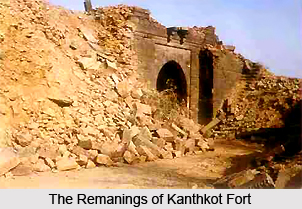 Kanthkot is an old fort about 5k.m. circularly situated on the top of an isolated rocky hill. It has walls built of massive blocks repaired in many places by smaller stones. This place was the capital of Kathis in 8th century and it was taken from them by the Chavdas. After the Chavda, the Solankis occupied the fort and thereafter the Vaghelas. Mod befriended Dharan Vaghela and Dharan gave not only Kanthkot but also his daughter in marriage to Mod`s son, Sad. Sad lived in Kanthkot and made it his capital. Sad started to build a fort on Kanthkot hill but he could not succeed because a part of the wall crossed the hearth of the great local ascetic Kanthadnath. In anger he destroyed it. Then Sad`s son Ful, named the fort Kanthadurg and was allowed by Kanthadnath to finish it. Bhimdev sought shelter from Mahmud of Ghazni in 11th century at Kanthkot. Kanthkot passed to the Deda branch of Jadejas and at the close of the 16th century is mentioned by Abdul Fazal as one of the chief Kutch forts. In 1816 it surrendered to a British detachment under col. East when the fortifications were razed to the ground. To the west of the hill in a ravine are two large deep wells and one ruined step well built of blocks of sandstone. On the hill are the remains of three temples: One dedicated to the ascetic Kanthadnath, the second a Jain temple for Mahavir and the third, a temple of the sun.
Kanthkot is an old fort about 5k.m. circularly situated on the top of an isolated rocky hill. It has walls built of massive blocks repaired in many places by smaller stones. This place was the capital of Kathis in 8th century and it was taken from them by the Chavdas. After the Chavda, the Solankis occupied the fort and thereafter the Vaghelas. Mod befriended Dharan Vaghela and Dharan gave not only Kanthkot but also his daughter in marriage to Mod`s son, Sad. Sad lived in Kanthkot and made it his capital. Sad started to build a fort on Kanthkot hill but he could not succeed because a part of the wall crossed the hearth of the great local ascetic Kanthadnath. In anger he destroyed it. Then Sad`s son Ful, named the fort Kanthadurg and was allowed by Kanthadnath to finish it. Bhimdev sought shelter from Mahmud of Ghazni in 11th century at Kanthkot. Kanthkot passed to the Deda branch of Jadejas and at the close of the 16th century is mentioned by Abdul Fazal as one of the chief Kutch forts. In 1816 it surrendered to a British detachment under col. East when the fortifications were razed to the ground. To the west of the hill in a ravine are two large deep wells and one ruined step well built of blocks of sandstone. On the hill are the remains of three temples: One dedicated to the ascetic Kanthadnath, the second a Jain temple for Mahavir and the third, a temple of the sun.
Roha Fort
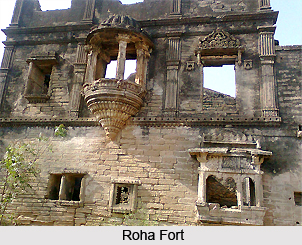 Roha fort is situated on the hillock of the same name 50 Kms. from Bhuj. It is connected by main road and covers an area of 16 areas. The height of Roha hill is 500 feet from the ground level and 800 feet from the sea level. Roha was the leading Jagir of Kutch state. There were 52 villages under this Jagir. Rao Khengarji I (1510 - 1585) established Kutch and he became a ruler of Kutch. His brother Sahebji set up Roha village. Thakore Sahebji fought with Raysihji Zala of Halvad and he died in this battle. After Thakore Sahebji`s death his successor Jivaji built two big tanks on the Roha hill and his son Thakore Noganji built a fort on Roha hill. Thakor Khengarji was honoured by Maharao Deshalji of Kutch and he got a close place in Darbar of Bhuj. His granddaughter Rajba married with Kalapi Thakor saheb of Lathi dist. Surendrangar. Thakore Kalapi was famous poet in Gujarat. He has written many poems which are still read. He wrote romantic poems at Hohal hill because atmosphere of Roha was peaceful and close to the nature with many peacocks and other birds which can be seen here even now. Roha is called Sumari Roha after the princesses of the Sumara state Umarkot in Singh. Fleeing Allaudin Khilji, the princesses sought asylam with Abda, the Jagirdar of Abdasa, in the 10th centre. Abda died fighting Allaudin Khilji who pursued the princesses to Kutch. Consequently, the princesses, numbering 120, took samadhi in Roha which till now commemorates the princesses who gave up their lives for saving their honour.
Roha fort is situated on the hillock of the same name 50 Kms. from Bhuj. It is connected by main road and covers an area of 16 areas. The height of Roha hill is 500 feet from the ground level and 800 feet from the sea level. Roha was the leading Jagir of Kutch state. There were 52 villages under this Jagir. Rao Khengarji I (1510 - 1585) established Kutch and he became a ruler of Kutch. His brother Sahebji set up Roha village. Thakore Sahebji fought with Raysihji Zala of Halvad and he died in this battle. After Thakore Sahebji`s death his successor Jivaji built two big tanks on the Roha hill and his son Thakore Noganji built a fort on Roha hill. Thakor Khengarji was honoured by Maharao Deshalji of Kutch and he got a close place in Darbar of Bhuj. His granddaughter Rajba married with Kalapi Thakor saheb of Lathi dist. Surendrangar. Thakore Kalapi was famous poet in Gujarat. He has written many poems which are still read. He wrote romantic poems at Hohal hill because atmosphere of Roha was peaceful and close to the nature with many peacocks and other birds which can be seen here even now. Roha is called Sumari Roha after the princesses of the Sumara state Umarkot in Singh. Fleeing Allaudin Khilji, the princesses sought asylam with Abda, the Jagirdar of Abdasa, in the 10th centre. Abda died fighting Allaudin Khilji who pursued the princesses to Kutch. Consequently, the princesses, numbering 120, took samadhi in Roha which till now commemorates the princesses who gave up their lives for saving their honour.
Tera Fort
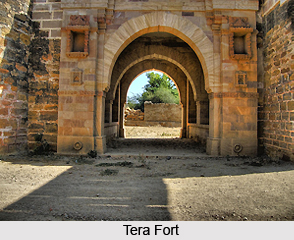 Tera lies 85Kms, west of the town of Bhuj in the Abdasa taluka of Kutch district. Thakor Sumaraji and his wife Baisaba was lover of arts. They renovated Darbargadh in 1845.Tera castle on the western edge of the state of Gujarat dominates the plains of Kutch from its position on the banks of Tretara (Three lakes). There are three lakes namely Chattasar, Sumerasar and Chatasar.
Tera lies 85Kms, west of the town of Bhuj in the Abdasa taluka of Kutch district. Thakor Sumaraji and his wife Baisaba was lover of arts. They renovated Darbargadh in 1845.Tera castle on the western edge of the state of Gujarat dominates the plains of Kutch from its position on the banks of Tretara (Three lakes). There are three lakes namely Chattasar, Sumerasar and Chatasar.
Maharao Deshalji (1819 - 1860) rules in Kutch. He belonged to the Jadeja clan of Rajputs. He had two sons. Elder was Ravaji (Pragmalji) and second youngest was Gagubha (Hamirji). Maharao Deshlji loved Gagubha very much. He decided to install him as the ruler of Tera Jagir. Tera Jagir consisted of 41 villages and was one of the largest Jagirs of Kutch state.
There are Ramayan wall paintings in the Tera castle, done by kamanger painters. Entire panel is 21.9 mtrs. Long 87cms wide are on the four walls of his bed room. The one right corner and eastern wall proceed anticlockwise. There are elaborate carved and beautiful paintings on glass in the Jain temple. There are some carved Jarukhas and ruins chhatris statues in the town Tera. Bandhani (tie & die) Block printing, mirror work, Jats embroidery are the main crafts of this town.
There are many of wild life animal`s chinkara, Blue Bull, Wild Boar, Hyena, The Great Indian Bustard, Peacock, Black partridge etc. A very famous Mahadev temple Pinglaswar is 35 Kms far from Tera.



















